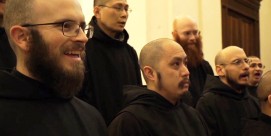Masters of Mercy
Between 1854 and 1863, Japanese artist Kano Kazunobu (1816-1863) created a series of 100 paintings of the Buddha’s 500 disciples. Very early Buddhist sacred texts suggested that during one of the Buddha’s famous sermons, 500 followers received instant enlightenment. These disciples became known as “the worthy ones,” and fascination with them was a staple of Japanese Buddhist iconography. Kazunobu interpreted this ancient idea of “the worthy ones” and intertwined with it popular themes from his own era to create lively, richly colored, and highly detailed scenes of the disciples. His 19th century scroll paintings range from depictions of monastic life and duties to images of the disciples performing miracles, such as saving people from hell or relieving a drought. Watch our interview about Buddhism and Kazunobu’s paintings with James Ulak, senior curator of Japanese art at the Smithsonian Institution’s Freer Gallery of Art and Arthur M. Sackler Gallery. Masters of Mercy: Buddha’s Amazing Disciples is on display through July 8, 2012 at the Sackler Gallery in Washington, DC. Produced by Jonathan Stroshine and Lauren Talley. Interview by Lauren Talley. Edited by Lauren Talley and Fred Yi.
JAMES ULAK (Senior Curator of Japanese Art, Smithsonian Institution’s Freer and Sackler Galleries): These are the designated closest disciples of the living Buddha in the time in the fifth century before the Christian era when he preached his message in what is now northeast India.
These close followers who later received the canonical number of five hundred became known as “the worthy ones.” In Sanskrit, the language of the day in India, Sanskrit calls these people arhats. You hear different names applied to these five hundred. The point of Buddhist fascination with these five hundred followers is that they take the role of intercessors and messengers from the Buddha, teaching compassion, showing that the Buddha’s life can be lived on earth, and they take on the role of supermen. The idea was that they were enlightened but yet living among us. And so they were able to show us how to live but yet also conduct these intercessory miraculous acts to save us from our sufferings.
Kazunobo created this ensemble of one hundred paintings between 1854 and 1863. The ancient purpose of painting these one hundred paintings of the five hundred followers was to give a kind of approachable, easy to see Buddhist catechism. Now I use that phrase very loosely, but it became a vehicle to show to people the basic modes for living a good Buddhist life.
The Buddha’s message, of course, was that to achieve enlightenment one has to tear away from the bonds of any attachment to essential experience. The notion in Buddhism is that everything is changing, everything is in transition, nothing is permanent, and everything we see, everything we grasp for in the material world is ultimately deceptive.
The primary question at least for the general population of his day who were viewing them was that in the midst of all of this we can have hope that there is, that the Buddha dwells among us and in us. You see that in all of the paintings.
He attempts to show you how these five hundred worthies lived their life in a monastery. There’s a wonderful pair of paintings that shows the masters of mercy as they take part in the daily communal bath. It was not just a question of hygiene, but a question of gathering together in a communal way to underscore the idea of the Buddhist community. My guess is that Kazunobu actually went down the street to his local public bath, looked at different people doing different things—a man shaving, a man clipping his toenails.
You get a real sense of compassion extended to all living things. There’s a great painting done of the arhats interacting with the animal world, the natural animal as we know it and the mythical animal world, and they’re at comfort with these creatures. There’s a painting where a unicorn-like animal is crouching in front of a seated arhat, and the arhat is cleaning his ear. Next to him is a little, another monk, and on his shoulder perched like a house cat is what seems to be an ocelot.
You see, if you will, natural history borrowings from other information they have from outside, but you also see the Buddha through the vehicle of these masters of mercy embracing everything, telling everyone everything’s all right. We care for you. We’re like you, but we’re not like you. We have this toggle role within your universe.
There’s a wonderful painting where one sees in the pair of paintings in the foreground what was a dry stream bed or river bed, and you see in one painting water spurting out of the head of one of these monk-like characters, endless stream of water filling the dry stream bed. And in the other painting you see water pouring out of a pitcher that also seems to be an endless source of water.
When we look at the paintings we see a significant amount of narrative drama that involves murder, war, pillage, suicide, earthquakes, fires and these elements alone appearing in the five hundred worthies’ paintings I think is a bit unusual. And Kazunobu in his paintings was reflecting the tumult of the day. I don’t think it’s a stretch to suggest that he was an eye witness to certainly physical catastrophe and tried to depict that and to let his audience know that the mercies of the Buddha were there even for the suffering.
You see interventions. There’s a wonderful pair of paintings showing the worthy ones descending on clouds and hovering over the pits of hell where flames are licking at the damned and demons are poking at those who are condemned, and they come down to give mercy and in essence rescue. You see people condemned in hell climbing out of their terrible pit of torture and reaching up to a staff which one of the worthy ones is extending to his hand.
These would not be paintings you would sit in front of and meditate on. These are paintings that entertain and engage the eye. The eye cannot stay still. Every square inch of these paintings shows color, activity, detail that leave you constantly searching.
These humble looking gentlemen, these gnarled and whimsied old monks are really the embodiment of layers and layers of power inside of them. So there’s no need to show a central or overall dominant Buddha figure. The message is that the Buddha is within and moving about in very mysterious ways.







